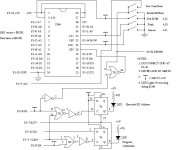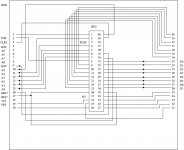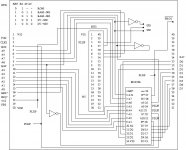Dwight Elvey
Veteran Member
Hi
On a suggestion from another friend, I'm starting a new thread rather than
continuing an older thread started by another.
I've been debugging my KIM-1 and while doing so, hopefully helping others.
What does one do when it doesn't work?
One can check some obvious places like the clock signals, reset pulse,
interrupts and sync signal.
Beyond that there is little that one can do with the monitor code dead.
The problem could be any of the chips, from the simplest 7404 to one
of the RRIOT chips.
I've always said that one should write code and use an EPROM to test the
functions of the board.
Now I'm putting actions to these words.
First one needs to create a place to put an EPROM if there is no socket.
That is what I did for the KIM1. I have created a small board with a minimum
of parts on a prototype board.
Here is the schematic. I will post test in later messages.
It uses a 2764, 7404, 7402 and 7474.
Dwight
On a suggestion from another friend, I'm starting a new thread rather than
continuing an older thread started by another.
I've been debugging my KIM-1 and while doing so, hopefully helping others.
What does one do when it doesn't work?
One can check some obvious places like the clock signals, reset pulse,
interrupts and sync signal.
Beyond that there is little that one can do with the monitor code dead.
The problem could be any of the chips, from the simplest 7404 to one
of the RRIOT chips.
I've always said that one should write code and use an EPROM to test the
functions of the board.
Now I'm putting actions to these words.
First one needs to create a place to put an EPROM if there is no socket.
That is what I did for the KIM1. I have created a small board with a minimum
of parts on a prototype board.
Here is the schematic. I will post test in later messages.
It uses a 2764, 7404, 7402 and 7474.
Dwight



